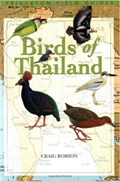| Mu
Ko Similan (Similan Islands) |
| Introduction |
Mu
Ko Similan Marine National Park in Pang Nga province is an
archipelago of 9 main islands in the Andaman sea. The islands and
islets are composed of volcanic granite, containing small areas
of beach forest and tropical forest, with some beautiful fringing
coral reefs. This National Park covers 128 square kilometres, 14
of which is the sum of all the land. This is a great place to stop
and recover from the rigours of birding in the hot, sweaty forests
on the mainland, with a chance of seeing a few good birds and maybe
adding to the list of birds seen in the National Park. |
The
best time to visit the Ko Similan is between December and
April, when the weather is fine and the sea clear, making
for good snorkelling and safer travel.
The
scenery at Mu Ko Similan is spectacular, with the colours
of grey rocky outcrops, white sandy beaches, lush green rainforest
and clear blue seas contrasting with one another. Sunsets
can be a wonderful sight here too, with it being the last
place in Thailand to see the sun set each day! A visit to
the Similan Islands is likely to be one that is remembered
a long time after returning home. |
|
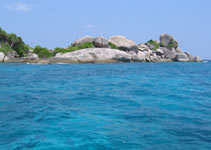
Ko Similan
Rocks
(Photo by Nick Upton) |
|
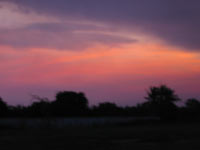
Ko Similan
Sunset
(Photo by Nick Upton) |
|
| Ko
Similan
is open to tourists once again after disruption by the tsunami of
December 26th 2004. However, the National Park is closed anually between
mid May and mid November due to adverse sea conditions. |
|
About
Google adverts |
| Birding
Highlights |
| Most
birders who make the trip to Ko Similan do so to see the Nicobar
Pigeons which are seldom-seen bird due to the inaccessibility
of the islands upon which they live. In March 2004 these were
easily seen foraging around the toilets and tents in the campsite
on Ko Miang (island number 4) which is a very pleasant place
to stay for a few days. Other highlights are the close up
views and large numbers of Pied Imperial Pigeons, and regular
sightings of White-bellied Sea Eagle.
At
dusk this island comes alive with fruit bats, clouds of them
noisily fighting over the fruit in the trees. If you have
a phobia of bats, this isn't the place for you!
Click
here for a checklist of the birds of Mu
Ko Similan |
|
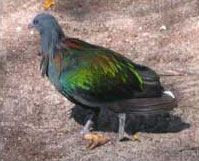
Nicobar Pigeon
(Photo by Srasri
Phiromyothee) |
|

|
|
Bird
Tours : Check the suggested itineraries
for ideas on creating a tailor-made birdwatching trip
to Thailand: Thailand
bird tours. |
|
|
| Travel
Information |
|
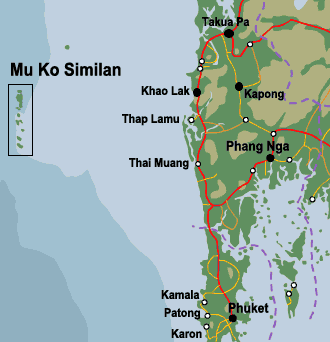
|
|
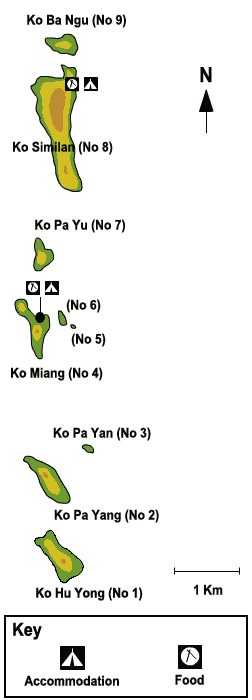
|
|
To go to the Similan islands, one must get to the village
of Thap Lamu (pronounced Tap LaMoo). If arriving by car just
take the turning off the main Phuket (PooGet) -Takua Pa (
TakooWa Par) road to the park headquarters. It is sign posted
in English so it is easy to find. The headquaters is a kilometre
or two from the pier, but it is the best place to park. After
buying the National Park entrance ticket the staff will arrange
transport to the pier where boat tickets to the island can
be purchased.
If
traveling by bus from the north, the quickest way is to come
via Surat Thani (SooRat TarNee) and Takua Pa and get the bus
to stop at the turn off for Thap Lamu. Here it will be neccessary
to take a motorcycle taxi a few kilometres to the park HQ
for about 20 baht. If traveling by bus from the south, any
bus to Ranong from Krabi or Phuket will pass the turning for
the park HQ.
From
Thap Lamu there are a few companies running boats to Ko Miang.
I took a speedboat for about 1500 baht per person in 2004,
which only took an hour and a half. There did appear to be
one slow boat per day for a lower price, but after a rather
unsteady slow boat to Ko Surin, the speedboat felt very secure!
m |
|
|
About
Google adverts |
| Finding
Birds |
| Finding
birds on Ko Miang doesn't take a lot of effort due
to its small size. Currently, very few species have been recorded
in Mu Ko Similan National Park, so there is potential to add to
this list.
Nicobar
Pigeons can be easily seen in and around the campsite. I found the
early morning to be the easiest time to see them foraging around
the tents, but it was possible to see them later in the day, especially
in the damp areas behind the toilets. They are very tame, allowing
people to approach within a few metres and offering plenty of time
to take photos even with the smallest of cameras.
Pied Imperial
Pigeons were numerous throughout the island but it seemed easiest
to get good views of them from the water at Had Lek (small beach).
When I was there in March 2004 they would come to fruit trees along
the bay to feed a few hours before dusk. They were particularly
acrobatic in their approach to landing and can be spotted quite
far away due to the contrasting colours of their plumage and the
forest. Not quite as tame as the Nicobar Pigeons, they fed on fruit
only a few metres above the beach and could be approached to within
about 10 metres.
White-bellied
Sea Eagles can be seen anywhere around the National Park, but were
particularly visible from Hat Yai (big beach) in the early morning
and late afternoon. |
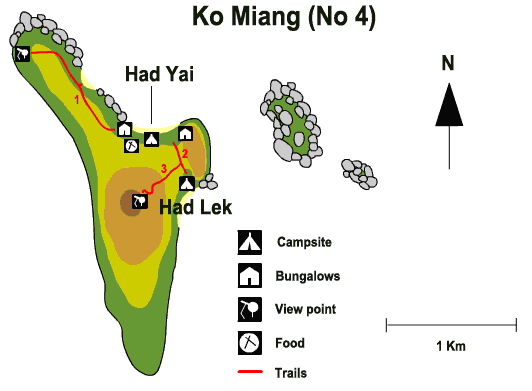
|
There
are a few places to walk and find birds on Ko Miang;
Trail
1:
This starts behind the bungalows on the west of Had Yai and runs
for about one kilometre. It goes through some good-looking forest
leading to a view point on a rocky outcrop. This is apparently the
most westerly point in Thailand and consequently the last place
in the country to see the sun set. If you go to see the sunset be
sure to take a torch as the trail is quite rocky and dangerous in
the dark.
Trail 2: This
short trail leads from Hat Yai to Had Lek, lasting about 350 metres.
The forest is very lush and there are hundreds of roosting bats
in the trees. In the early morning this trail contained a few interesting
birds including Forest Wagtail and White-breasted Waterhen. |
| Trail
3:
This trail starts about halfway along trail 2, lasting about
500 metres and takes the walker very steeply up to a view
point. Towards the end it is neccessary to use ropes to pull
oneself up huge boulders to the top, so wear good shoes here.
From the top is a spectacular view across Had Yai and Pied
Imperial Pigeons can be seen flying around the tree tops.
I also saw a single Green Imperial Pigeon along this trail
on my visit. It would be a very good idea to climb this trail
early in the morning before the temperature rises too high!
Had
Yai campsite:
This
large campsite contains many mature trees with feeding Pied
Imperial Pigeons, Asian Koels and Collared Kingfishers easily
seen from the tent as well as the star of the show; Nicobar
Pigeon on the ground. Brahminy Kite and White-bellied Sea
Eagle can be seen from the beach itself.
Had
Lek:
This is where the best views of pied imperial pigeon are easily
had. Collared Kingfisher and Pacific Reef Egret can also be
found here. Snorkelling from this beach is recommended too,
it is sheltered and uncrowded but the water is fairly deep. |
|
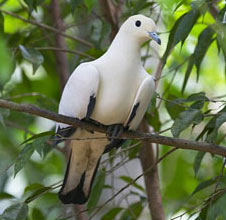
Pied Imperial
Pigeon
(Photo by Hans
Stel) |
|
| Facilities |
|
About
Google adverts |
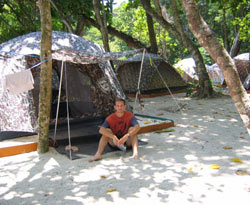
Me at Had
Yai Campsite
(Photo by Srasri Phiromyothee) |
|
Only
two of the islands have accommodation for visitors; Ko Miang
(No 4) and Ko Similan (No 8). However, the long beach at Ko
Hu Yong (No 1) is a nesting site for turtles and it is possible
for small parties to stay here by special arrangement to view
the turtles. Accomodation on Ko Similan (No 8) is limited
to tents, either pre-pitched tents at 400 baht per night or
your own tent at 40 baht per night/ per person. Food is sold
here too.
Most
birders will want to head for Ko Miang, where it is easy to
see Nicobar Pigeons. For those who like a bit of comfort there
are a number of National Park bungalows for rent. These can
be of variable quality, and one young Thai couple I met who
stayed in a bungalow said they wished they'd chosen a tent
instead. However, the bungalows on stilts on the beachfront
of Had Yai (big beach) looked very romantic and appealing
at night. |
|
Most
people are happy to camp in the pre-pitched tents close to
the beach. These are quite sizeable and although the 400 baht
per night fee seems a bit much, it does include bedding rental
which is provided clean every day. It is not possible to pitch
your own tent on this island. Toilets and showers are plentiful,
spacious and clean considering where you are but it is important
to conserve water where possible.
A short
walk through the forest brings you to the quieter Had Lek
(small beach) where the same camping options are available,
although food is not. This would mean walking a few hundred
metres in the dark to eat in the evening, so bring a flashlight
if intending to stay here. |
|
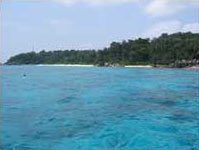
Had Yai,
Ko Miang
(Photo by Nick Upton) |
|
The
following table lists the accommodation available at Mu Ko Similan
which are supposed to be booked before arrival at the National Park
Department in Bangkok; 61 Phahonyothin Road, Chatuchak, Bangkok
10900. If your Thai isn't up to scratch I'm not sure how successful
this would be, but the number to call is; 02 579 7223 or try booking
through the internet at www.dnp.go.th
Please only
use this list as a guide, I'm sure the prices have changed now due
to restoration work after the tsunami of 2004.
Most people
who want to camp just book the tents when they arrive at park headquarters
on the mainland at Thap Lamu (pronounced Tap LaMoo). |
Accommodation
Name |
No
of rooms |
No
of persons |
Price
(baht per night) |
Island
No |
| Chom
view |
| Similan |
| Poo
Kai 1 |
| Poo
Kai 2 |
| Hu
Yong |
| Pa
Yang |
| Pa
Yan |
| Pre-pitched
Tent |
| Own
Tent |
|
|
|
| 2000 |
| 1000 |
| 600 |
| 600 |
| 600 |
| 600 |
| 600 |
| 400 |
| 40/person |
|
|
| |
|
Behind
the main campsite on Ko Miang there is a restaurant where decent
Thai food and drinks are served. The food served is adequate but
nothing to write home about, however the location makes up for it.
A small selection of the normal toiletries are sold here in case
you forget them and there is also a first aid room to deal with
any minor accidents.
While
visiting the Similans it is worth taking a snorkelling trip. These
leave every day and cost 200 baht per person per day, with different
locations visited every day. The coral and fish are quite impressive
and sea turtles are common. Snorkelling equipment and life jackets
are available for rent on the island. More extensive diving trips
can be arranged with tour companies back at Thap Lamu. Mu Ko Similan
is renowned for the quality of its diving locations. |
 |
| Donations |
If
you found this page useful, please consider making a donation.
|
| Other
Related Pages |
Birdwatching
Tours
Other
Southern Thailand Birding Locations
Jan
Wilczur's Bird Art: Gurney's Pitta, Banded Pitta & Rufous-collared
Kingfisher |
| Trip
Reports |
|
| Useful
Books |
| Thailand's
Islands and Beaches |
| Photo
Galleries |
|




|
| Tags |
| birds,
birding,
thailand,
nature, national
parks |

